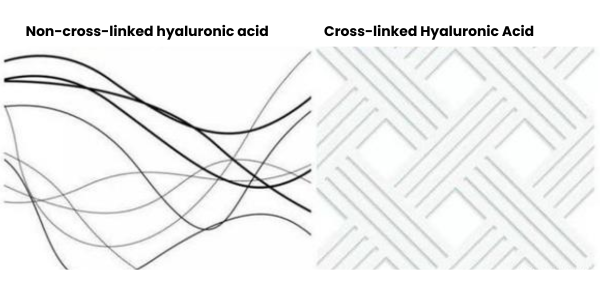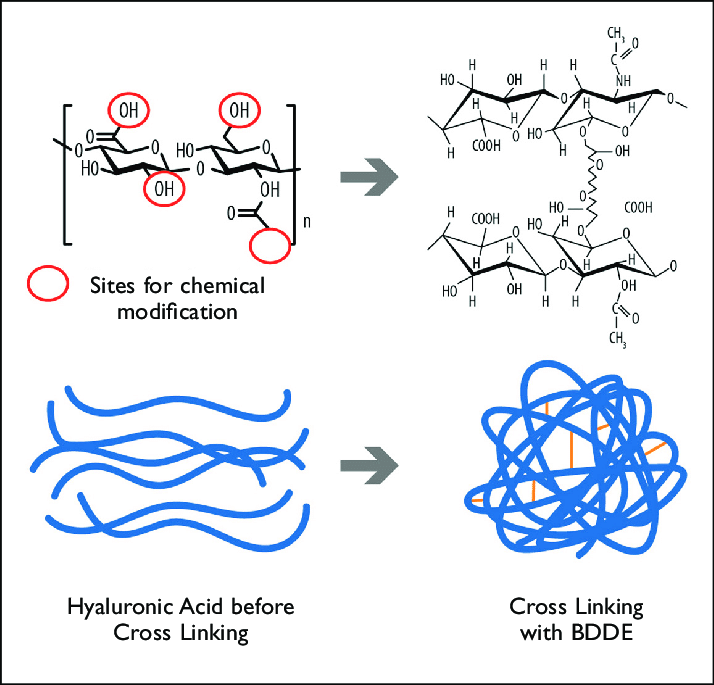
What is Hyaluronic Acid
Hyaluronic acid (HA) is widely found in the extracellular matrix of human tissues. It is a key component of skin, vitreous humor, joint synovial fluid, and cartilage. HA has excellent moisturizing properties, viscoelasticity, and biocompatibility. It performs multiple functions, such as retaining tissue moisture, supporting soft tissue structure, lubricating joints, and promoting wound healing. HA is an extremely important biomedical material. It has been widely used in medicine, cosmetics, and biotechnology, including applications like dermal fillers, ophthalmic viscosurgical devices, and osteoarthritis treatment.
What Factors Affect the Quality of Hyaluronic Acid
HA purity, molecular weight, and three-dimensional structure all directly affect quality. Increased molecular weight and networked structure tend to promote increased water retention and viscoelasticity. High-molecular-weight HA contains more crosslink sites, therefore a denser 3D network. This not only retains water but provides additional mechanical reinforcement and biocompatibility, especially in medicine and tissue engineering. Also, high-pure HA containing a specific molecular structure reduces side effects and allergies and is thus safer and more effective in drug delivery and medical aesthetics.
Cross-linking Provides Hyaluronic Acid with a Denser Network Structure
HA is highly soluble and rapidly hydrolyzes at room temperature. This can happen at the expense of structural integrity and may need to be counteracted. HA is often hydrochemically modified and crosslinked to stabilize it. Crosslinking is now the most prevalent method of structural modification of HA. It uses cross-linking agents with reactive groups at both ends to form covalent bonds with active groups on neighboring HA chains. This process connects multiple linear HA molecules into a 3D structure. Typical groups that react are hydroxyl and carboxyl groups. Figure 1 illustrates this process from the case of BDDE, using HA’s linear shape and how it gets modified after crosslinking.[1]

Fig 1. cross linked hyaluronic acid vs non cross linked
Cross-linking causes HA macromolecules to locally aggregate and fold densely, forming a tighter network structure. This process enhances both the structure and functionality of HA itself. It can bind more water molecules, and its form transforms from a sol to a gel.
The resulting hyaluronic acid hydrogel retains the original physicochemical properties while achieving an increased molecular weight. Cross-linked HA also exhibits low toxicity, resistance to hyaluronidase degradation, and excellent biocompatibility. These features give it broad applications in cosmetics and medicine, including skin fillers, cartilage regeneration, and osteoarthritis treatment. Additionally, this hydrogel serves as an ideal delivery carrier for both water-soluble or oil-soluble drugs.
SCC Provides Crosslinked Hyaluronic Acid Gels:
- Single-phase crosslinked HA
- Biphasic crosslinked HA
Reference:
1. What Are the Benefits of Sodium Hyaluronate Crosspolymer
2. Cross-linked HA Gel Hyaluronic Acid Powder
[1] Humzah, Dalvi & Romagnoli, Marina & Tateo, Antonello & Bellia, Gilberto. (2021). Hyaluronic acid: a strategic molecule for rejuvenating procedures. Esperienze Dermatologiche. 22. 10.23736/S1128-9155.20.00508-7.
